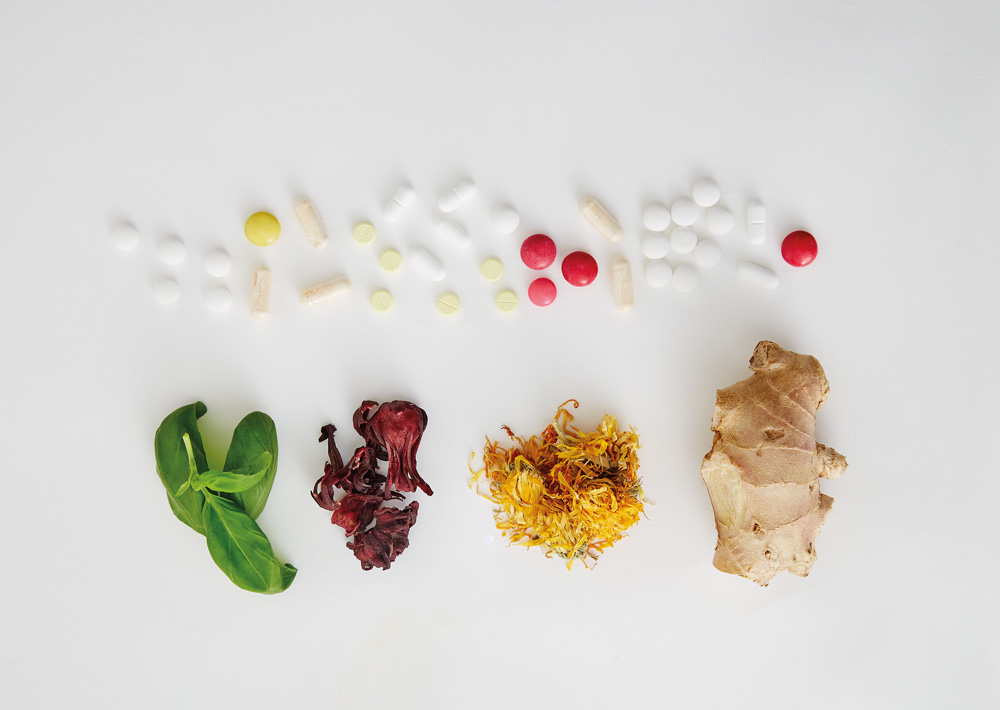The herbal medicine debate: pharmaceuticals vs farmerceuticals

Remedies are big business. Worldwide pharmaceutical revenues have reached nearly $1trillion and according to a new report from Global Industry Analysts, the global herbal medicine market is forecast to reach $107billion.
There continues to be a divide between followers of modern western pharmacy and those who believe herbal medicine is a more holistic response to illness. What’s universal is that most people want the safest, most effective and, at times, cheapest option available. But deciding what’s best isn’t always easy – the manufacturing process, your personal physiology and how treatments react with each other all play a vital part in their ultimate effectiveness.
The history of herbal
Let’s get this straight, western medicine has its origins in traditional herbal medicine. In the 19th century, there was the realisation that active ingredients found within plant remedies were the drivers of symptomatic relief within a patient.
Over the last 30 years, 877 small molecule drugs have been introduced worldwide, and 61% can trace their origins back to natural products. Similarly of 121 prescription drugs used worldwide against cancer, 90 are currently derived from plants.
A combination of negative publicity, a lack of qualified research and our trust in all things ‘scientific’ are some of the main proponents against the use of herbal remedies, particularly in developed countries. But considering the origin of many modern medicines, the question being asked is can humanity efficiently replicate millions of years of natural evolution? In an attempt to partially answer such an incredibly complex question, we can examine the origins of one of the most notable modern medicines.
For thousands of years, crushed willow bark has been prescribed for ailments such as aches, pains and reducing fevers. The ancient Indians, Egyptians, Sumerians and Chinese all used it, and Greek physician Hippocrates is on record as prescribing it many times in the event of headaches. As modern chemistry developed, it was discovered that the anti-inflammatory agent salicin was the active ingredient within the bark.
Science quickly isolated the ingredient and in 1897, Felix Hoffmann synthesised acetylsalicylic acid that was later marketed as aspirin. In low doses, aspirin appeared to have some very beneficial effects, however higher doses led to adverse reactions such as stomach bleeding and gastric ulcers; side effects that weren’t typically associated with the use of natural willow bark.
How do they compare?
One of the challenges with modern medicine is that the use of conventional dried herbs consists of both soluble and insoluble components that aren’t always easily absorbed by a patient’s body. However, through millions of years of evolution, the natural world has developed a solution to this intricate interaction between living species. Naturally occurring biological fluids called micro-emulsions have evolved to essentially aid the transportation of medicine into the bloodstream.
Science is starting to confirm what herbal practitioners have long believed, that whole plant extracts offer the correct form of medicine where these additional compounds (and not just the ‘active ingredient’) play an important and vital role.
Recent scientific evidence to support this hypothesis offers a new understanding and perspective on how herbal medicines work, and a possible answer as to why willow bark is as effective as aspirin for reducing pain and inflammation, but at a much lower dose.
This is an important distinction. Everything in our thinking is all about cause and effect, and we love nothing more than trying to isolate the cause of anything negative and often use modern scientific methods to address this solitary issue.
Need more knowledge
For many centuries, the echinacea root, for example, has been considered to have beneficial impacts on immune function. In our western mindset, we tend to think of this as being the ‘important bit’ without considering the rest.
And so we go to the pharmacy and purchase the thing that says ‘echinacea’ on the label, without realising the echinacea root has many secondary constituents, and that you need at least two secondary ingredients for it to have any impact on your immune function.
Even more concerning is that in recent DNA testing on a variety of herbal supplements sold throughout retailers in the US, only 21% of products had verified DNA from the plants listed on the products’ labels. This is why sometimes we use herbal supplements and they don’t work. It can happen because of three different reasons: either the producer has failed to understand the dynamic properties of the source product; he is unable to systematically reproduce the remedy in a way that nature intended; or the products are misleading in their ingredients.
Warning: Don’t mix
Combining treatments between prescription drugs and herbal medicines can cause complications. Dr Hsiang-Wen Lin and a team of experts from the China Medical School in Taiwan found that almost half of adverse reactions were caused by the herbal medicine altering the process by which a drug is absorbed, distributed, metabolised and eliminated by the body. Flaxseed, echinacea and yohimbe were the herbal ingredients that were found to cause the greatest number of adverse drug interactions.
In short, herbal medicines themselves aren’t the problem, it’s a lack of understanding about the cause and effect of using multiple treatments that is still woefully incomplete.
FIND YOUR BALANCE
1. Nature’s call
Pharmaceuticals can make a huge difference on a short-term basis and may even save your life. But when it comes to chronic long-term problems, plant-based remedies can offer a more sustainable solution than popping pills.
2. Ask a pro
Combine treatments with caution and check with an expert first to ensure that ingredients won’t cause adverse effects.
3. Cheap is not cheerful
Invest in quality supplements that aren’t packed with binders. Check the label and look for raw ingredients where possible.
4. Aid digestion
Take probiotics alongside antibiotics to reduce the risk of side effects such as diarrhoea and vaginal thrush in women.
5. Double act
Don’t just assume that you can simply replace pharmaceuticals with herbal remedies, or vice versa. They can aid – or counteract – each other, so do your research.
Read more: Does holistic pain relief actually work?








